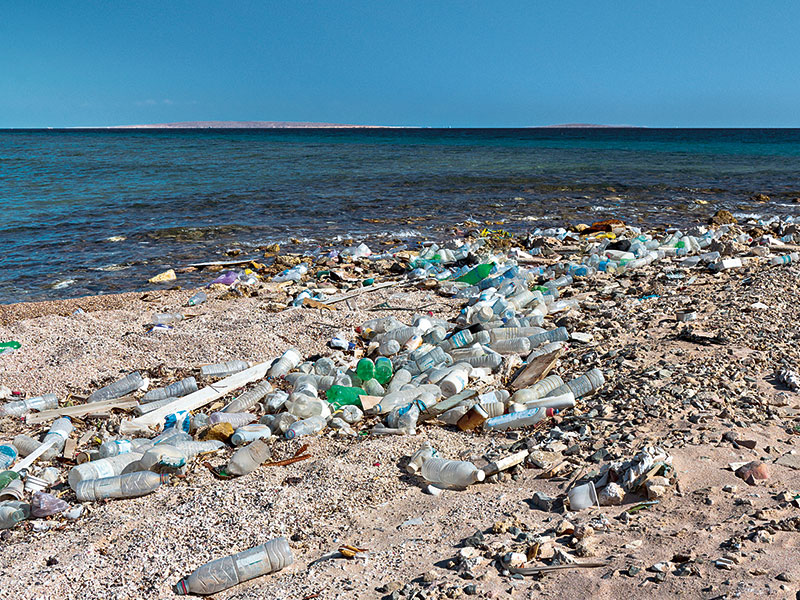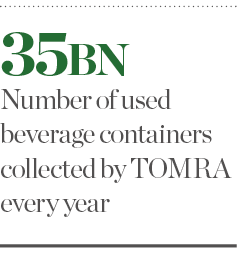
Our planet is facing a waste crisis: more than eight million tonnes of plastic enters our oceans every year; fewer than half of all plastic bottles are collected for recycling; and one third of all food produced globally is never eaten. You don’t have to be a mathematician to know that our industrial model is not sustainable, and that unprecedented action is required to stop us from destroying the planet. In essence, we need a paradigm shift in the way we produce and consume fresh food and goods.
Many of us in the recycling industry are convinced a resource revolution is already taking place, and that a circular economy will soon become a reality. Action is no longer just for activists: technology innovators are showing companies how to gain value from waste through a powerful combination of expert knowledge and cutting-edge solutions, such as artificial intelligence (AI) and machine learning.
It’s through these clever applications – which help to unlock the full potential of local and global farmland, as well as make cities smarter and more sustainable – that TOMRA and other ambitious companies are leading the transformation towards a circular economy.
Wasted opportunities
A key area for change lies in plastics. Our use of plastic has increased 20-fold over the past 50 years, and it’s expected to double again in the next two decades. For manufacturers, plastic brings unrivalled functional properties at a low cost. Indeed, there is nothing inherently wrong with the material itself, but it does have a disastrous effect on the environment when it’s not collected and recycled effectively.
A burgeoning economy is emerging from the process of recovering, washing and sorting plastic taken out of waste streams
But managing plastic more sustainably doesn’t have to be arduous. In fact, a burgeoning economy is emerging from the process of recovering, washing and sorting plastic taken out of waste streams. What’s more, innovative sensor-based technologies – like the reverse vending machines (RVMs) developed by TOMRA in 1972 – are making this collection process a convenient part of everyday life.
Today, the use of RVMs at supermarkets allows people to deposit their empty beverage containers for a small refund, driving huge increases in recycling rates – up to 98 percent, in some cases. TOMRA itself captures 35 billion used beverage containers every year, representing 2.5 percent of the total sold in 2017. Clearly, there is still much more to be done.
By collecting a greater volume of plastic packaging materials, it is estimated that we can introduce around $100bn (€86.3bn) of value back into the global economy. To achieve this, TOMRA provides pioneering, sensor-based sorting solutions to the waste and metal recycling industries, recovering many types of valuable materials from the waste stream and sorting them efficiently. In other words, we literally turn waste into value.
Manufacturers and brand owners can also benefit from making new products out of recycled plastics. Consumer packaged goods account for around 40 percent of plastic use, so it is reassuring to see some of the world’s largest brands committing to the use of recycled raw materials. Naturally, the market wants recycled material that is of a high enough quality to be reused; if this is achieved, virgin material could be replaced entirely.
Fortunately, brand owners are already working with technology companies on lighthouse projects that replace virgin plastics with 100 percent recyclates. This includes redesigning products – around 80 percent of a product’s environmental impact is determined at the design stage – and developing ‘closed loop’ recycling for plastic materials.
Trash talk
The accelerated sustainability movement is being supported by both consumer demand and legislation. The European Commission has set new targets for member states to recycle around 70 percent of packaging waste by 2030. Some countries are far off these goals and don’t have the necessary infrastructure in place, so it will take significant investment, as well as collaboration with technology innovators that are working hard to reshape the industry.

Restrictive policies such as China’s National Sword initiative – which was introduced in February and bans the import of 24 types of waste material, as well as greatly increases the required purity level of accepted items – are also having a major impact. The world’s reliance on China as a dumping ground for pre-sorted (but dirty) waste has been thrown into sharp focus. Consequently, countries in Europe and North America are sitting on a lot of plastic, realising they must invest in their domestic waste management capabilities.
At the same time, consumers are demanding that products be made responsibly, and have placed a greater emphasis on the environmental, social and ethical practices of brand owners. Both of these factors are motivating companies to change their processes and products.
Food for thought
Resources go beyond plastics, however, and another key area in which technology is acting as a catalyst for change is the food industry. Imagine if we could reduce vast amounts of food waste by making sure every product is grown, harvested, handled and stored more efficiently. Ambitious companies like TOMRA are transforming the global food supply chain by using sensor-based technology to increase yields and perform sophisticated food analysis and grading.
This technology can be applied to fresh foods, including fruit, vegetables and nuts, which must be carefully treated to avoid perishing, as well as to processed foods such as French fries, which must meet consumer expectations every time. Through automation, thousands of items can be sorted every minute, providing huge commercial benefits to food producers.
Sensor technologies can also tell producers how ripe an apple is, how long it can be stored and, as a result, where and when it should be delivered to consumers. The same technology means that retailers may be able to guarantee an apple’s sweetness, raising its market value. Essentially, the art of farming has become a science.
But the use of technologies such as automation, blockchain, AI and machine learning goes far beyond producing the perfect apple. According to the UN, the global population could reach 9.8 billion people by 2050, a feat that would require approximately 70 percent more food to be produced than is consumed today. With urban populations growing, the chance of increasing farmland proportionately appears slim.

What’s more, consumers are more empowered than ever: they demand not only fresh, local and healthy food, but also variety, traceability and year-round supply. This is making the food supply chain even larger and more complex, highlighting the importance of automation to the market of the future.
Fortunately, traditional producers are already making moves in this area. In precision agriculture, for example, sensors attached to plants are measuring the levels of irrigation and fertiliser required for each crop, increasing yields by some 30 percent. ‘Agritech’ – such as mechanical harvesters and sorters – is also helping farmers overcome labour shortages, while fresh-food processors are benefitting from having several stages of automated quality control before distribution, protecting their clients and their reputations.
New technologies have already shown numerous industries that it is possible to create economic value in a way that also benefits society. TOMRA’s vision of ‘leading the resource revolution’ strongly reflects this: its technology is helping businesses capitalise on long-term trends, such as the circular economy and the future of food.
By transitioning from the role of supplier to critical partner, TOMRA is forging strategic relationships and making selected investments that will help to meet the industry’s future demands. Whether relating to recycling or the food industry – or many other sectors, for that matter – these technologies provide invaluable benefits to consumers, businesses and the environment alike.

